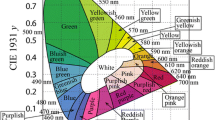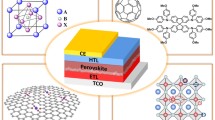Summary.
Organic opto-electronic devices comprise one or more organic layers and the electrodes. The interfaces between these very different components play a crucial role to the performance of the devices. In donor–acceptor composites for photovoltaics, the electronic processes occurring at the interface will benefit from a particular interface morphology on the 10–100 nanometer level; this is demonstrated for composites of oligophenylenevinylene and C60. Phase separation on such a scale may be achieved naturally in diblock copolymers. The synthesis of an OPV–C60 diblock copolymer is described.
Similar content being viewed by others
Author information
Authors and Affiliations
Additional information
Received June 23, 2000. Accepted (revised) July 18, 2000
Rights and permissions
About this article
Cite this article
van Hutten, P., Hadziioannou, G. The Role of Interfaces in Photovoltaic Devices. Monatshefte fuer Chemie 132, 129–139 (2001). https://doi.org/10.1007/s007060170152
Issue Date:
DOI: https://doi.org/10.1007/s007060170152




